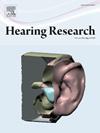Influence of visual analogue of speech envelope, formants, and word onsets on word recognition is not pronounced
IF 2.5
2区 医学
Q1 AUDIOLOGY & SPEECH-LANGUAGE PATHOLOGY
引用次数: 0
Abstract
In noisy environments, filtering out the relevant speech signal from the background noise is a major challenge. Visual cues, such as lip movements, can improve speech understanding. This suggests that lip movements carry information about speech features (e.g. speech envelope, formants, word onsets) that can be used to aid speech understanding. Moreover, the isolated visual or tactile presentation of the speech envelope can also aid word recognition. However, the evidence in this area is rather mixed, and formants and word onsets have not been studied in this context.
This online study investigates the effect of different visually presented speech features (speech envelope, formants, word onsets) during a two-talker audio on word recognition. The speech features were presented as a circle whose size was modulated over time based on the dynamics of three speech features. The circle was either modulated according to the speech features of the target speaker, the distractor speaker or an unrelated control sentence. After each sentence, the participants` word recognition was tested by writing down what they heard. We show that word recognition is not enhanced for any of the visual features relative to the visual control condition.
视觉模拟语音包络、共振峰和单词开始对单词识别的影响不明显
在噪声环境中,从背景噪声中滤除相关语音信号是一个重大挑战。视觉线索,比如嘴唇的动作,可以提高对语言的理解。这表明,嘴唇运动携带着有关语音特征的信息(例如,语音包络、共振峰、单词开头),这些信息可以用来帮助理解语音。此外,言语包络的孤立视觉或触觉表现也有助于单词识别。然而,这一领域的证据相当复杂,并且在这一背景下还没有研究过共振体和词的起病。本在线研究调查了两个人对话音频中不同视觉呈现的语音特征(语音包络、共振峰、单词起头)对单词识别的影响。基于三个语音特征的动态变化,将语音特征呈现为一个圆圈,其大小随时间而变化。根据目标说话人、干扰说话人或不相关的控制句的语音特征调制圆圈。在每句话之后,通过写下他们听到的内容来测试参与者的单词识别能力。我们表明,相对于视觉控制条件,单词识别对任何视觉特征都没有增强。
本文章由计算机程序翻译,如有差异,请以英文原文为准。
求助全文
约1分钟内获得全文
求助全文
来源期刊

Hearing Research
医学-耳鼻喉科学
CiteScore
5.30
自引率
14.30%
发文量
163
审稿时长
75 days
期刊介绍:
The aim of the journal is to provide a forum for papers concerned with basic peripheral and central auditory mechanisms. Emphasis is on experimental and clinical studies, but theoretical and methodological papers will also be considered. The journal publishes original research papers, review and mini- review articles, rapid communications, method/protocol and perspective articles.
Papers submitted should deal with auditory anatomy, physiology, psychophysics, imaging, modeling and behavioural studies in animals and humans, as well as hearing aids and cochlear implants. Papers dealing with the vestibular system are also considered for publication. Papers on comparative aspects of hearing and on effects of drugs and environmental contaminants on hearing function will also be considered. Clinical papers will be accepted when they contribute to the understanding of normal and pathological hearing functions.
 求助内容:
求助内容: 应助结果提醒方式:
应助结果提醒方式:


